

MOTO: CUM STUDIO ET HONORE – With Zeal and Honour.
Beginnings – On 10 February 1919, when the school doors were thrown open to admit students, 55 boys were enrolled and soon after, increasing to 63. Later in the year, the Spanish flu struck, and the school was closed from late August till mid-October, and when school resumed, student numbers had reduced to 42.
Numbers would continue to grow, and 40 years later, in 1959, at the school’s closing, numbers totalled around 900 boys.
A name change came in 1949 when the school became known as the Launceston Technical High School. The school continued its emphasis on trade subjects but gave more attention to academic subjects to enable students to enter tertiary institutions. Initially, the course was over two years, but by 1924 had been extended to three years to qualify for the Intermediate Certificate and later still in the 1940s to four years to qualify for the Schools Board certificate. Matriculation classes were established in the early 1950s.
The decision to establish Technical Schools in Tasmania was made following a report made to the Government by the Superintendent of Technical Education in New South Wales (Mr. J. Nagel) and the Director of Education in Tasmania (Mr. W.T. McCoy). Four technical schools were planned, Hobart, Launceston, Queenstown and Zeehan. The Hobart and Launceston schools took in only boys, whereas Queenstown and Zeehan included boys and girls, although at Launceston, one girl was admitted in 1924 and attended all scheduled classes. The intent was “that children leaving Primary Schools at the end of 1918 would have the opportunity of obtaining further education to fit them, especially for their future occupations as tradesmen”.
To gain entrance, students were required to be under 13 years of age and have passed the “Ability Test” under the Qualification Examination or the equivalent. This had the effect of bringing together students with above-average abilities. Over the life of the Launceston school, students were admitted from schools across the north of Tasmania, from Smithton to the Tasmanian East Coast, including King and Flinders Islands.
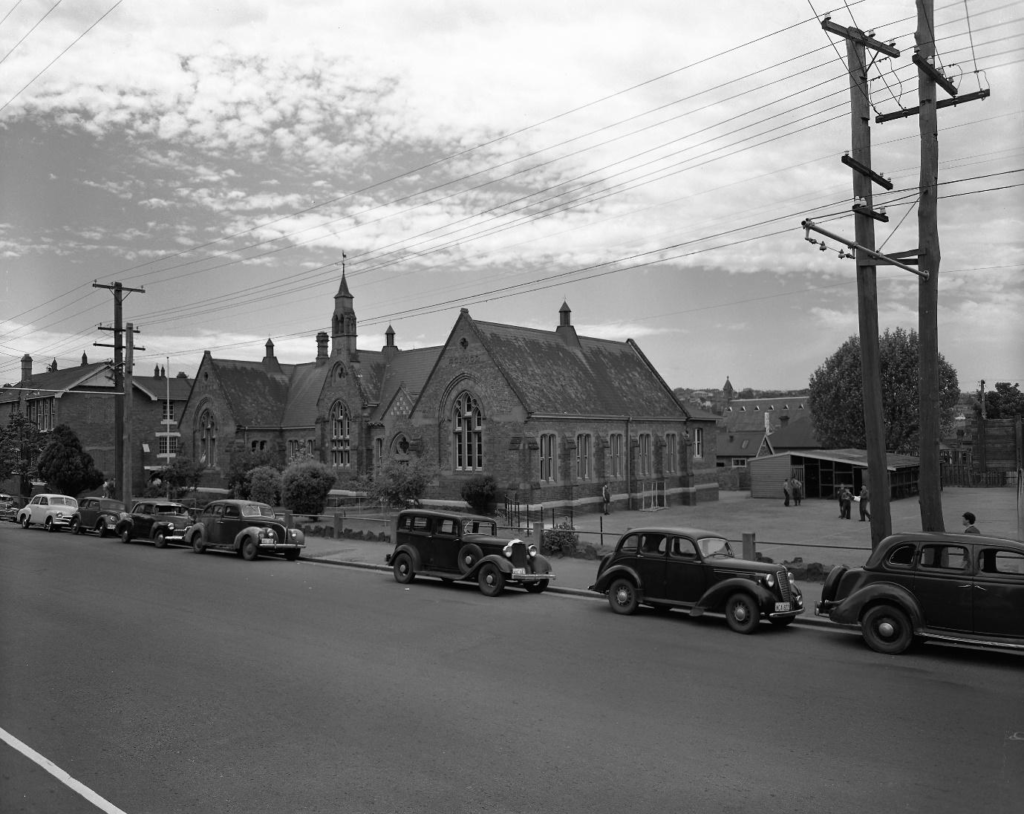
Subjects at Launceston to be studied were mathematics, English, history, geography, physics, chemistry, and in the first year, the technical subjects of woodwork, sheet metal work, applied geometry and artwork. In the second year, besides general scholastic subjects continuing from year one, the technical studies were expanded to the theory and practice of engineering, blacksmithing with mechanical drawing or into further woodwork training and building drawing. The third-year syllabus included the elementary theory of electricity and magnetism with appropriate laboratory work and instruction in elementary wiring. The year included much practical work with scholastic subjects continuing to be taught.
The gaining of technical skills was important, but of greater importance was the building of a manly, upright character in boys. Headmaster after headmasters promoted this theme.
Over the life of the school, classes and teachers had to contend with cramped and substandard classrooms, financial and equipment constraints, epidemics, and staff shortages, particularly during the Depression and war years. Yet, a school of excellence was established, with many students going on to occupy high positions in the history of Tasmania and beyond.
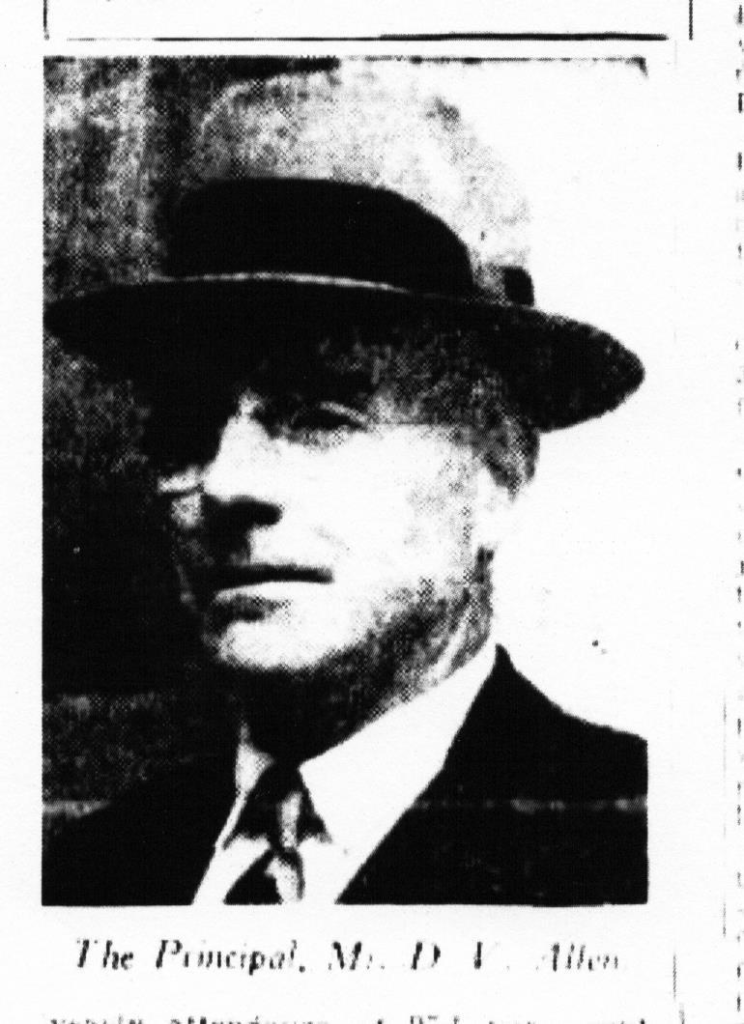
First Headmaster of the Junior School – 1919
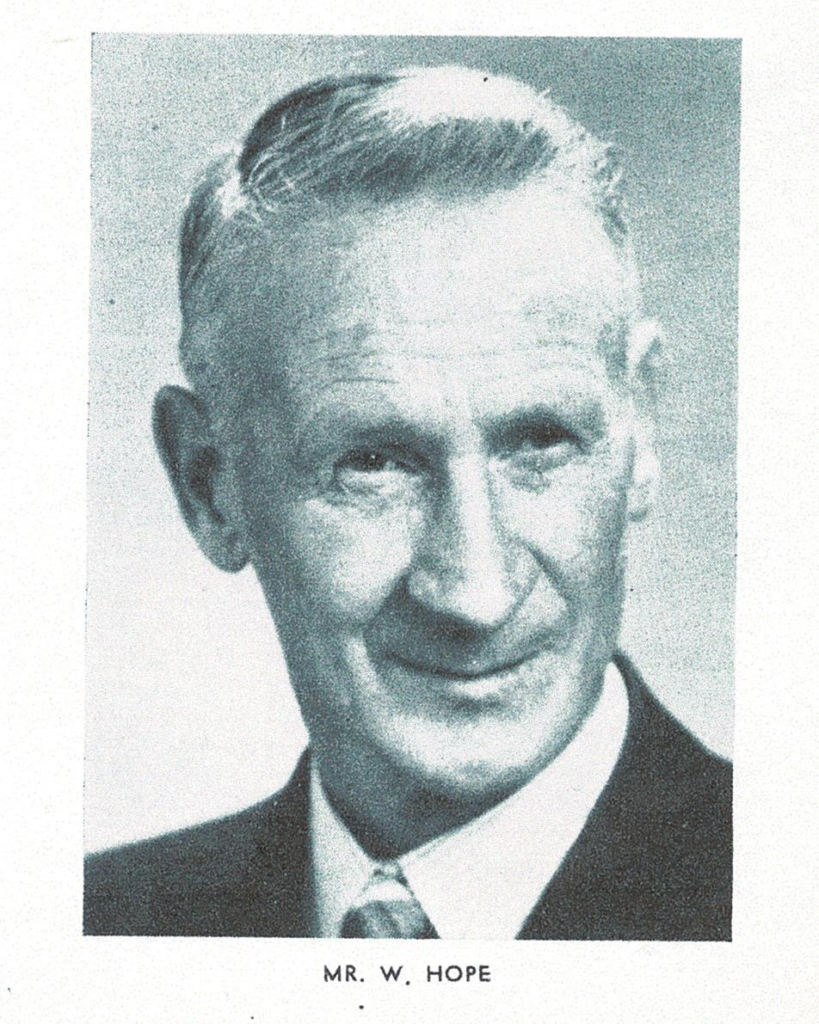


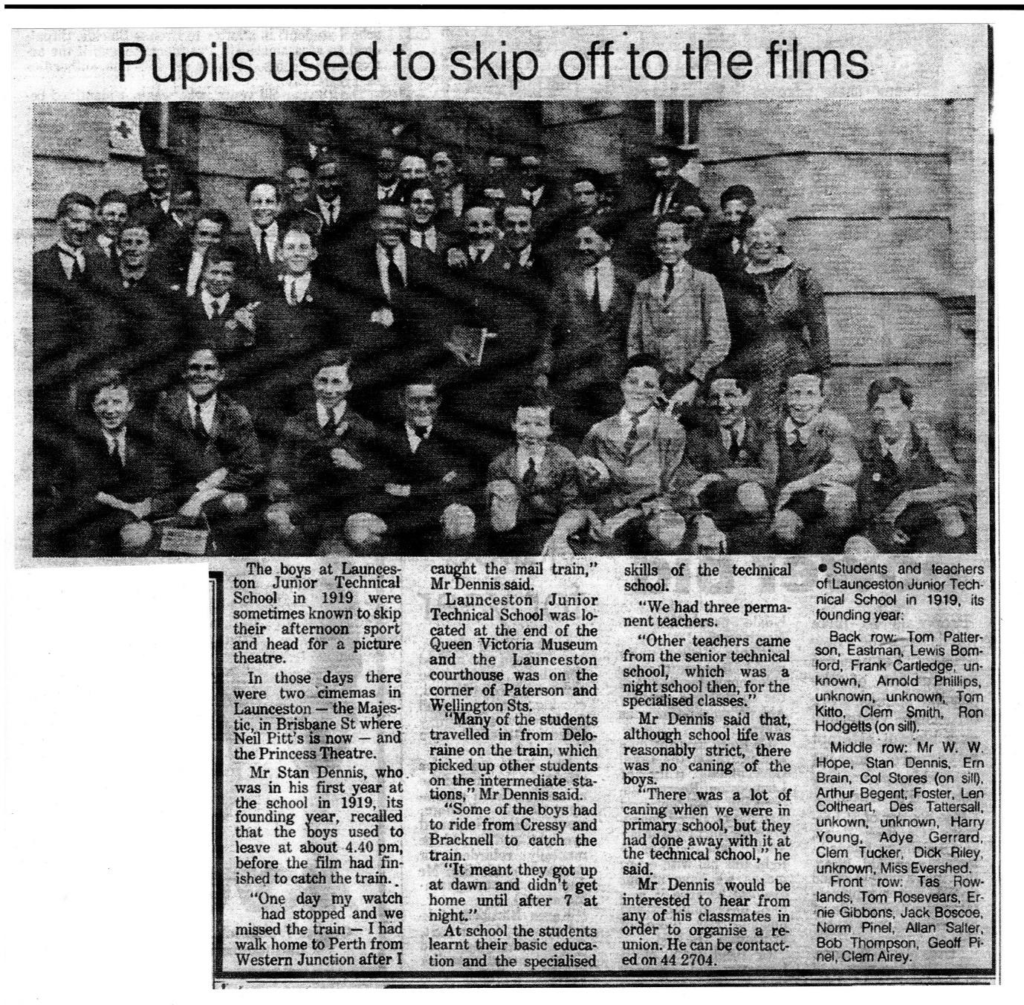
Initially, classes were held in rooms at the Queen Victoria Museum and in the Technical College. In 1930 on the relocation of the Supreme Court, the former building was offered to the school until demolition could take place, this delay was due to funds not being available as a result of the depression. The floor was replaced, and lighting was installed, with it being used as a gymnasium, assembly hall and, at times, a classroom. It would remain in use till 1940.

By the year 1940, the Wellington Square Primary School had closed, with its rooms made available to the Launceston Junior Technical School. However, the adjoining kindergarten operating out of the Gothic-styled building was not transferred for another two years and till then the yard was shared but divided by an imaginary line.
With the school growing (in 1941 an enrolment of 293) classroom space remained under pressure and outside rooms were rented, one being rooms in Paterson Street, located opposite the fire station. There tech drawing classes were conducted, also a metal workshop containing lathes and drills etc . A second schoolroom/assembly hall was set up at the Reed Memorial Church on Wellington Street, a block distant from the Wellington Square school. Both were occupied during the war years.
With increasing student numbers (580 in 1955), further classrooms were needed, and during 1954 two prefab buildings, each containing two rooms were erected at the Bathurst Street end of the Wellington Square campus. They remained in use till 1960, when the school was fully transferred to Queechy. It reopened as the co-ed Queechy High School.
First Teachers
Staff at the opening in 1919 consisted of the College Principal, Junior School Headmaster and four teachers. Mr D.V. Allen had overall control of both the Senior and Junior schools, operating from shared premises with a headmaster taking care of the day-to-day operations of the Junior school. Mr Walter Miller was appointed headmaster but at that time was away overseas, and during 1919 Mr William Walter Hope acted in the position.
Teachers – 1919
- William Walter Hope (1892-1979). William, sometimes known as Walter or Barney, had a long association with the Tech school, periodically teaching there over a period of more than 25 years. He mainly taught woodwork and metalwork but at other times general subjects, including chemistry and maths. He was an able teacher and is remembered as a strong disciplinarian. He is pictured above in the 1919 school photo.
- Alfred Alexander (1885-1937). Alfred was a cabinet maker by trade and at the school taught woodwork. While at the school, he perfected the making of laminated framed tennis racquets. He resigned from Tech in February 1924, leaving to establish his building business. However, he quickly moved to the business of manufacturing laminated tennis racquets, which became known as “Alexander Racquets” and were sold worldwide. He continued with contact and support of the school.
- George William Roberts (1882-1964). George was born in England and travelled to Tasmania in 1918, returning here after being a previous resident from 1910 to 1917. He is recorded as being an engineer, but at the Tech school is recorded as teaching fitting and turning. He retired from the school in 1950.
- Miss Hope Sarah Evershed (1876-1957). Hope was an Art teacher from 1919 and had previously taught in the Senior College. She was a well-known artist, highly trained and successfully entered numerous exhibitions. Hope was well regarded at the school and taught there until 1934, when she was forced to go on leave due to illness. She is pictured above in the 1919 photo of students and teachers.
Other Tech Teachers – 1920s
The 1920s was a time of growth and development at the school. In 1924 student numbers reached 100 growing to 210 in 1930. To cater for the increasing numbers, more teachers were recruited –
- 1921 – three additional teachers appointed
- 1922 – Mr P.G. Phillips joined the school, transferring from the Zeehan Technical School. He taught building drawing. He retired from Launceston Tech in 1948.
- 1923/24 – Mr Alfred Alexander resigned and was replaced by Mr. Rowland and Mr Tattersall. They were woodwork teachers.
- Mr W.G. Walker, a teacher of chemistry and electricity, left the school
- 1924 – Mr A.D. Mackay was appointed as a physics and chemistry teacher. He retired from Launceston Tech in December 1949.
- Mr V.V. Hickman was appointed to teach chemistry, previously teaching chemistry at the Zeehan Technical School.
- 1927 – Mr A.L. Cobden was appointed to teach Geometry.
More Tech Teachers
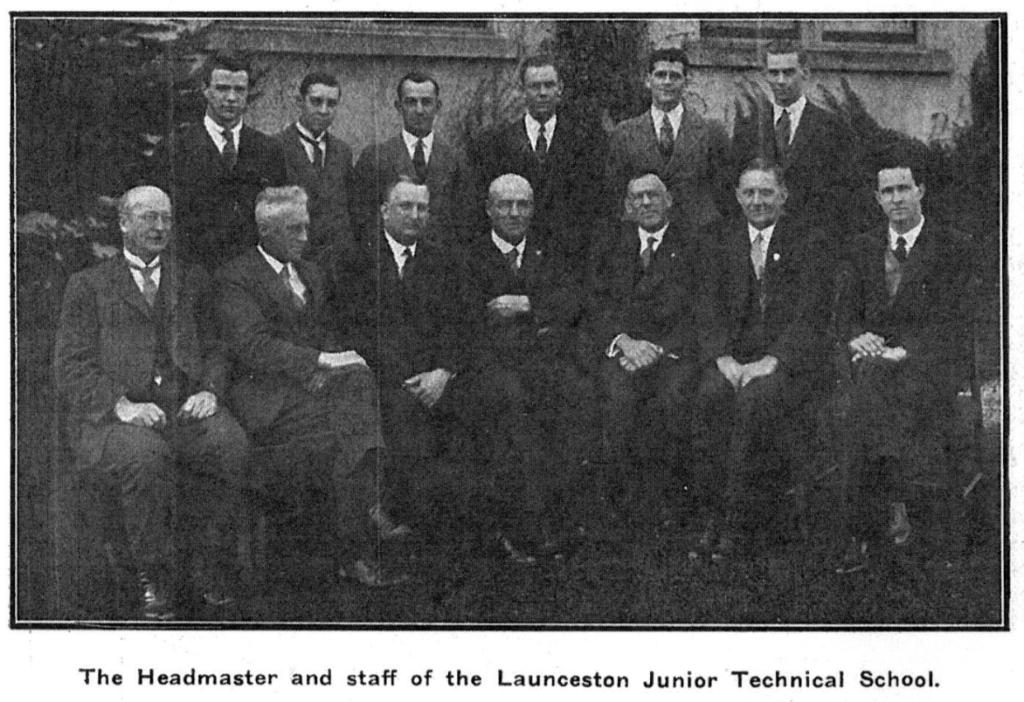
The teachers appearing in the Weekly Courier photo are not named in order of appearing, but a listing of names and subjects taught appeared in The Examiner newspaper on the same date, as follows-
- Mr W.L. Grace – Headmaster
- Mr A.L. (Austin Lewis) Cobden – taught Applied Geometry
- Miss H.S. (Hope Sarah) Evershed – Art Class
- Mr H.R. (Harold Robert) Evershed – Mechanical Drawing (a brother to Hope)
- Mr R. Payne – Sheetmetal Work
- Mr H. Cooper – Woodwork
- Mr P.G. (Percy George) Phillips – Building Drawing
- Mr G.W. (George William) Roberts – Fitting and Turning
- Mr A.D. (Alexander Dudley) Mackay – Physics
- Mr V.V. (Vernon Victor) Hickman – Chemistry
- Mr T.K. (Thomas Keith) Jebb – Electrical Wiring
- Mr C.A. (Cyril Alfred – Sam) Bickford – English
The Early Years – 1925 School Report
The Annual Report for the 1925 Year was presented by the School Principal Mr D.V. Allen at the annual breakup and prize giving function held on 16 December 1925.
It provides a comprehensive picture of the school’s activities for the year. The report follows-
“The enrolment during the year was the highest yet recorded, there being 155 pupils in attendance. This year inaugurated the three years’ course and the boys of the present first year class will not complete their course until 1927. The increased numbers naturally taxed the accommodation of the school, and extensions were currently to ease the situation. This has resulted in the completion of one side of the new building, laying the foundation of a structure which when completed, will be of great advantage to all concerned. “With the increased attendance the teachers have been called upon to teach practically every period, often having to take combined classes: to them we owe our thanks for the efforts they have made to make the school a success. During the year the parents have evinced a keen interest in the school, and by their co-operation a fair was held from which we raised over £50. This money is being devoted to the sports fund. Outstanding helpers were Mrs Willes, Miss Forsyth, Mesdames Phillips (2), Thompson, Ford, Griffiths, Clarke, Tanner, and others. To Mr. Alexander, a former member of the staff, we owe a deep debt of gratitude for his kindness in donating two racquets to the fair. Another earnest worker for the school is Miss Forsyth, who not only assisted greatly with the fair, but ran a concert on our behalf. To this lady we tender our sincere thanks. “At sport the outstanding event was the visit of a football team representing the Technical Schools of Melbourne, and although they were too good for us, the boys spent a very pleasant time in Launceston. Cricket and swimming have been carried on throughout the year, and we are pleased to see that the Education Department is likely to arrange free admission to the baths, as was the custom some years ago. We are for the first time the proud holders of the Anzac Shield, having been successful through the agency of G. Billing. We also hold the St. Patrick’s Cup which was competed for by school teams. The winning of these events has created a desire to retain them, and we hope to put up a good fight this year again. The fine display which has always characterised our exhibit at the Launceston Show was excelled this year, and Messrs Roberts and Phillips are to be congratulated on the work they are doing to advertise the school at this fixture. During the year medals were received as a souvenir of the exhibit sent to Wembley Exhibition. In his report for the year the Superintendent of Technical Education congratulated the school upon the good year’s work. He referred to the very pleasant school spirit to be observed. The annual picnic was held on Monday last as Swan Point, when a large number of boys and teachers journeyed down on the Rowitta. They were favoured by beautiful weather, and a happy time was spent. During the year we had the honor of having the new wing opened by his Excellency the Governor and Miss O’Grady. His Excellency was very interested and expressed appreciation of the work being done at the school. I have to express my thanks to the staff, all of whom have worked conscientiously and well on behalf of the boys. Mr Hope has had a large share of the organisation to see to, and he has always been willing to do extra work when needed. Amongst other things, he did a great deal of work to bringing the fair to such a successful result. Mr Rowland has always seen to the extra duties that constantly arise, besides which he undertook all the arrangements in establishing the Melbourne boys, and he did this to the great satisfaction of the visitors. Messrs Roberts and Phillips have seen to their departments in a very creditable manner and have maintained their standards. During the year Mr. Phillips paid a visit to Sydney Technical Schools, where he was able to get an insight into the workings of schools there. Messrs Hickman and Mackay have maintained their high level in the science department, and Mr. Evershed and Miss Evershed in the sheet metal, drawing, and art departments respectively.
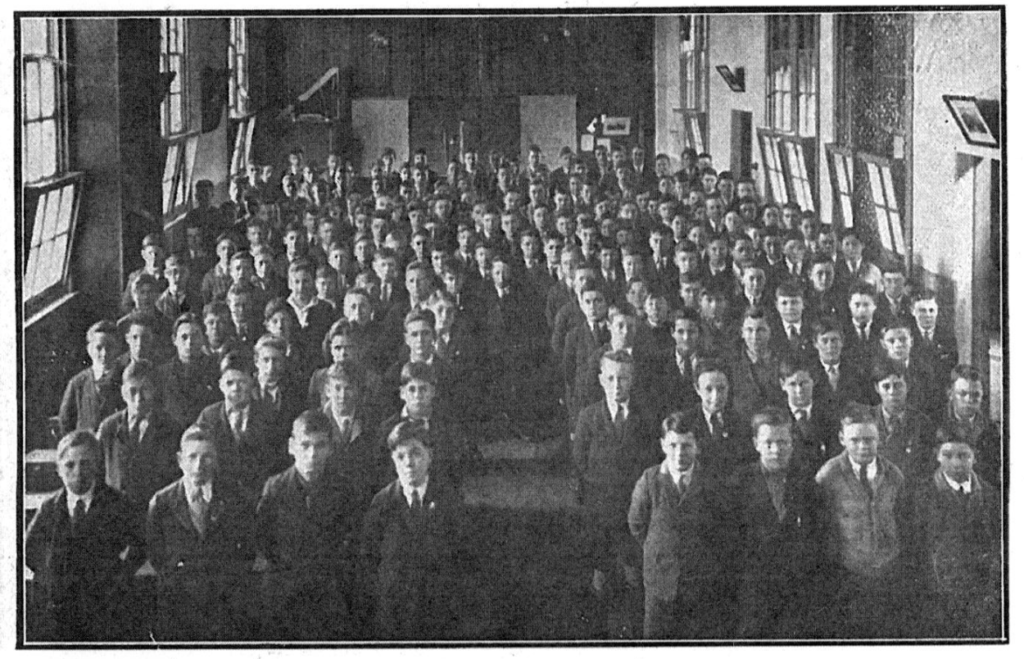
School Developments
1929 – An electric bell was installed throughout the school to facilitate changing classes.
1929 – The school song, “Here’s to our school, boys, with its noble aim” was written by the headmaster of the Glen Dhu State School, Mr. A.G. Waterworth and he was invited to the Tech school to hear it being sung by the boys. It contained three verses with a fourth added during the Second World War honouring past students who died while in service.
The first verse-
Here’s to our school, boys, with its noble aim,
Leading us to the higher things of life.
Here’s success to all who bring it fame,
In research or sport’s keen strive
Here’s to its precepts written on our hearts,
Words that save us many a painful fall
As through life we play our diverse parts.
To our school boys, the best school of all
To our school boys, the best school of all.
The song served to bind the school together and over the years was sung by thousands of boys.
1929 – An Honour Board depicting outstanding students from 1920-1928 was unveiled. It had been made in the school workshop department under the supervision of Mr P.G. Phillips. The board was made of Tasmanian Oak wood, and the lettering was done by Mr F. Deane. Names on the honour roll were – A. Phillips, J. Begent, L. Greenhill, F. Jans, H. Cooper, G. Moore, N. Pask, K Harris, and A. Lovell.

1929 – A prefect’s roll was designed and executed by Mr A.L. Cobden, a school staff member. The prefects’ badge was also designed by Mr Cobden.
1930 – During the year, the Prefect System was adopted.
1930 – “Hobby Hour” introduced
1931 – A reading room provided
1931 – Cleanliness encouraged by the donation of a silver cup presented for the cleanest room each week.
1937 – The House System. First mention of using headmasters’ names is found in the 1937 sports carnival results, but prior were named under house colours only. The school was divided into four groups, approximately equal in numbers and selected alphabetically. The houses were named after the first four headmasters, Allen, Miller, Grace and McLeod: house colours – Allen (Red); Miller (Blue); Grace (Green) and McLeod (Gold). Two further houses were established in the 1950s – Poimena (Purple) and Queechy (Brown). Teachers were also allocated equally to each house.
1942 – A gymnasium developed at the Wellington Square Campus, doubling as the school assembly hall. The gymnasium was fully equipped with mats, climbing ropes, Roman rings, medicine, and volley balls. Each Junior student now received 2¼ hours of physical training each week.
1944 – A school parliament, called the House of Representative, was established. Two people were elected from each class, making a House of 30 representatives. Their activity focussed on such things as repairs, school tidiness, and social functions.
1945 – A new school library was officially opened by Premier Cosgrove and named the L.M. Crocker Library. Miss Crocker was much involved in its establishment. The library was reputed as being one of the best school libraries in Tasmania.

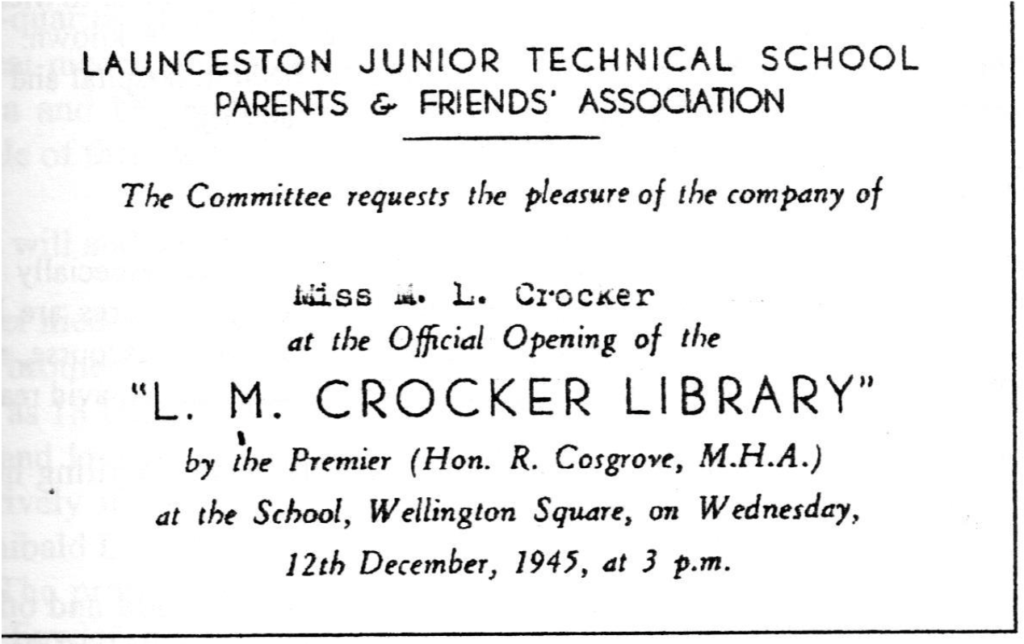
1946 – The issue of the school magazine, “Technicalities”, recommenced having been stopped over the war years.
1953 – A school hostel established, Poimena, at Button Street, Mowbray. It could accommodate 31 boys coming from country areas.
1958 – The school campus under construction at Queechy, opened its doors to 220 students, all boys. They would move to the Wellington Square school in 1959 for one year.
Tech – 1930s
During the 1930s decade, four headmasters presided over the Launceston Junior Technical School-
- 1930-1931 Walton Leonard (Tony) Grace
- 1932-1933 George James Dowling McLeod
- 1934-1934 (Jan to Jun) Frank Osmond Close
- 1934-1941 William Gilbert Speers
The 1930s decade was a very challenging time for the community and the school, with a severe depression occurring. Unemployment rose, wages slashed, and works programs put on hold. Also, school fees were introduced, making attendance at the Tech school unaffordable for many families Enrolments plunged from 210 in 1930 down to 108 in 1933. Later class numbers gradually increased (148 in 1935) and (237 in 1939).
A further challenge came in 1937 with the outbreak of a polio epidemic. In the Launceston area, by December 1937, there were 123 people hospitalised, most in the younger age group. In total, in Tasmania, over 2,000 people were affected, with 81 deaths.
There was much community fear, and people were encouraged to avoid people contact. Church worship services were closed, end-of-year school breakups were encouraged to be cancelled, and students who had gone home were advised not to return to school until the polio epidemic had subsided.
The gaining of work by students leaving school was much reduced, despite the best efforts of the school staff to assist. Headmaster Mr Grace gave much thought to the matter with the aim being to find ways of employment or at least activities to occupy leaving students. He put forward a plan noting that in the 1930 year, 74 boys or approximately 40 per cent of the school enrolment, had their homes in the country, which suggested the desirability of the Tech school adding a new subject to its courses in the direction of agricultural education. Mr Grace said that after going carefully into the matter, he was convinced of the value of such a course, and also its practicability, provided there could be made available an instructor in agricultural science and botany and an area of ground for experimental purposes. This work together with a knowledge of the use of tools and machinery gained in the various workshops should provide a course of inestimable value to country boys.
However, the proposal did not eventuate, probably due lack of available funding. High unemployment continued for several years.
Even so, the school flourished as indicated by Tech students gaining studentships, in 1935 out of eight available technical studentships, five were gained by the Launceston Junior Technical School, and then three years later, in 1938, of the eight studentships again available to the boys of the Junior Technical Schools of Tasmania, seven were gained by boys of the Launceston Junior Technical School.
The decade ended with the world plunging into a World War, with Australia joining on 3 September 1939, bringing further challenges.
Tech – 1940s
During the 1940s, two headmasters headed the school. –
- 1934-1941 William Gilbert Speers
- 1942-1951 Lewis Edney Amos
A significant event for the school was the move in 1940 across Paterson Street to the former Wellington Square Primary School, the brick two-storied building facing onto Wellington Street.
The building provided more classrooms and a greater recreation area. Moving to the new centre was the headmaster, library and school office. Some classes, particularly trade subjects, continued at the Technical College over the road.
A glimpse of school operations is provided by some memoirs written in 2019 by two former pupils of the 1940s. The first was by Norton Harvey, a student from 1941-1943 and the second by Lyle Cook, who attended 1943-1946. Both are now deceased.
Norton Harvey – Memoirs (in part)
Norton wrote, “My time at Tech (as it was commonly known) was during the war years and that had a big impact on activities. Staff shortages were common and there was even one term in 1942, where we didn’t have a teacher for one of the subjects. But we still had to sit the exam at the end of the term as it was a State-wide exam. Hobart had a big advantage as they had a teacher, but Launceston was a bit on the low side to put it mildly.
Class names today use Year 7 but in my time first year (1941) was C Class and the others B Class and A Class. C and B Classes were divided into six, hence C1, C2, etc. and A Class had A1 to A4. If my memory is correct the students were grouped alphabetically.
The photo in the Examiner shows the building, which was originally the Wellington Square State School. In my time LJTS used the two level building on the far left of the photo for classrooms for some subjects. They included, Art, English, Arithmetic, and Algebra, while some particular trade subjects, were in the Tech (now TAFE) building over the road. The centre building in the photo was still used by the State School for some junior classes.
The Woodwork class was in part of the Museum building,
The Physics lab, where Mr. Mackay taught, was in the upstairs room on the Paterson/Wellington Street corner of the Tech building.”
Lyle Cook – Memoirs (in part)
“Main Building – Our School building was situated on the Southwest corner of Paterson and Wellington Streets. We used the old Wellington Square building as a Gymnasium.
On the ground floor were rooms used as the School Office (Miss Cooper) an Art Room and a Drawing/Drafting Room (Mr. A.L. Cobden). At the entrance there was a large notice board with all classes and rooms, so all the students knew easily where the day’s work was to be held. Upstairs taking up two rooms was the library (Miss Crocker), then the Headmaster’s Office (Mr. Lou Amos) a more strict but fair man would be hard to find). Next room 5 (I think) English, History, (Shakespeare) etc Mrs Berwick, Mrs Holroyd, Mr. Woodruff, Mr. Whitchurch. Next door Room (6)?, Mathematics, Geometry, Algebra etc., by who else but (Mr. Jack Begent). Then the staff room at the end of the building.
LAUNCESTON TECHNICAL COLLEGE
We used rooms in this modern building for classes such as Tin Smithing (Mr. Lockhart), Drafting (Mr. Bradshaw), Physics and Chemistry (Mr. A.D. Mackey) and Mr. Ernie Norton. Blacksmithing (I think it was Mr. Bradshaw there also). Further down Paterson Street, opposite where the Examiner newspaper used to be, we used a workshop for metal work, mainly lathes and drills etc. (Mr. “Cog” Roberts). It was situated upstairs I think, next or near “Palm Grove” dance hall.
At the back of the LTC next to the Museum were the Woodwork rooms, theory and a large practical room full of woodworking stuff (Mr. Percy Phillips)”.
School – War Effects
At the start of the 1940s, the Second World War was raging and would continue for five years. Although combat fighting ceased in 1945, shortages in food, clothing, fuel, plus other items, necessitated rationing and continued for some years after wars end.
Norton Harvey and Lyle Cook commented on those years while students at Tech. in their memoirs.
Norton Harvey – “The school cadets were a major activity. I was in the cadets in 1942 and 1943. The Easter cadet camp in 1943 was held at Gowrie Park where there was a cluster of evacuation huts (each with a capacity of over 60) which were used to house the cadets from Launceston High, Launceston Junior Tech, Launceston Grammar, Scotch College, Devonport High and Burnie High. Total number I think was over 600.
Things were very different in those days. The cadet rifles were 310’s and we were issued with our rifle at the start of the year and took it home. We had to bring it in as required on parade days.”
Lyle Cook – “The Second World War was on well and truly when I started Tech in 1943. We had an Air Training Corps under one (Flight Lieutenant Jack Begent) and a cadet corps, Mr. Ernie Norton, was Lieutenant. Those who did not partake in things Military, played sport on the Thursday afternoon.
Because of the war there were shortages of everything, food, clothing and everything else. We all had ration tickets for food and coupons for clothing purchases. We had a School Fair once and we were asked to contribute whatever we could. My father sent so much stuff, eggs, homemade butter, potatoes, swedes and more, that left Mr. Amos and the other teachers quite speechless. I couldn’t understand the fuss as at home we had plenty of food!
Sometime in 1944/45 we had to assemble in Paterson St. to watch “G for George”, a Lancaster bomber buzz the City”.
1941 – There were frequent air raid rehearsals, and boys were issued with earplugs and gags.
1942 – In March, trench digging commenced in the yard. The boys did most of the work.
1945 – The school closed on V.E. day (Victory in Europe). Three months later, the war in the Pacific ended. The school was dismissed then for two days.
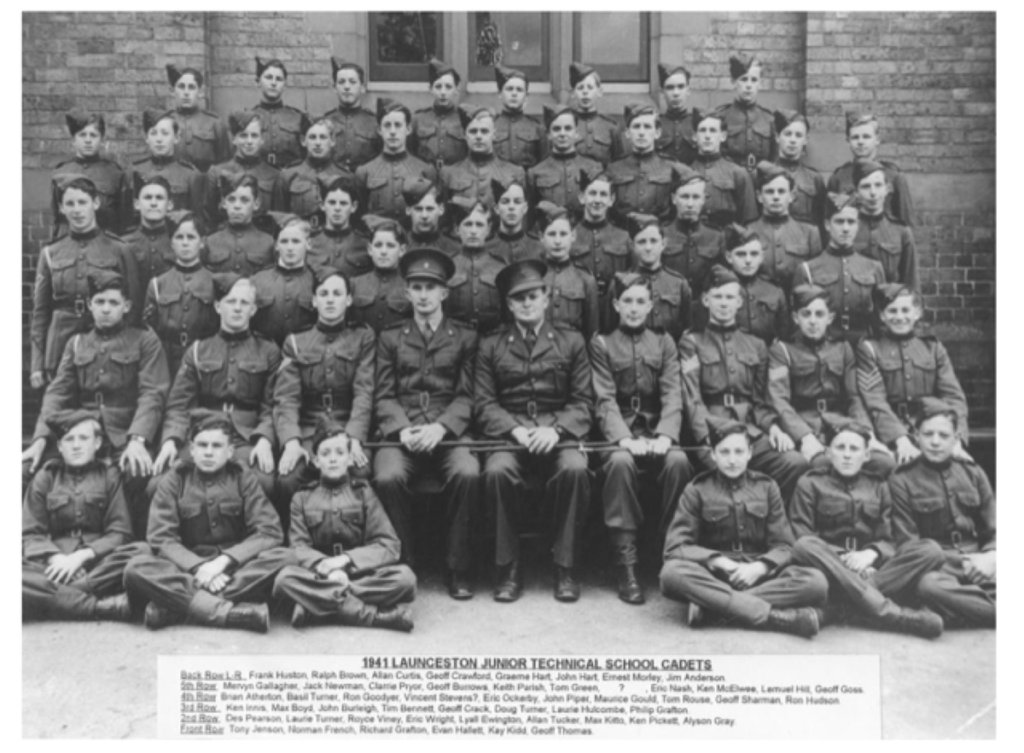
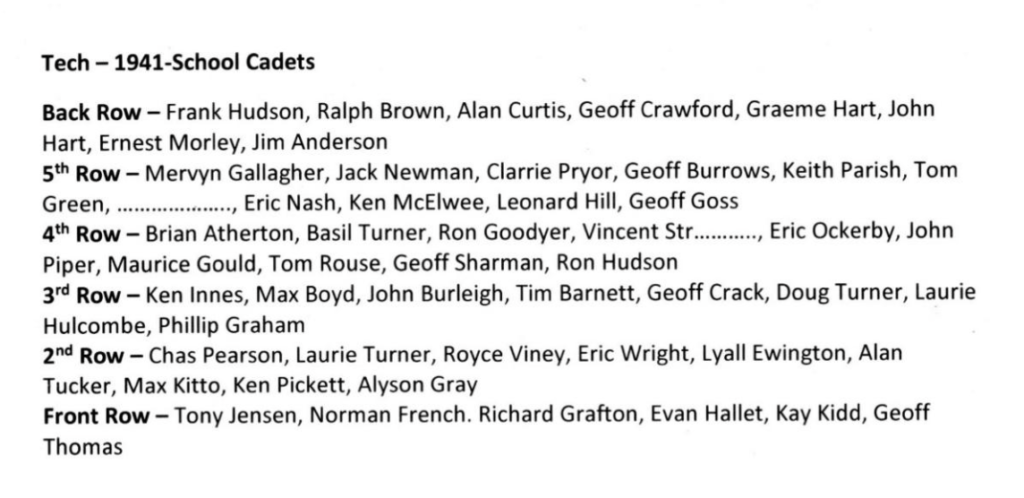
War Service
A number of Old Tech boys entered military service. By 5 July 1941, the Examiner reported that over 50 were serving overseas, with two missing. A year later, on 31 July 1942, 200 Old Tech boys were recorded as serving, and a year later (Ex: 31 July 1943), numbers had increased to 250. It was further reported that four had died.
Awards for Bravery
In the 1946 Technicalities magazine, the following awards were listed-
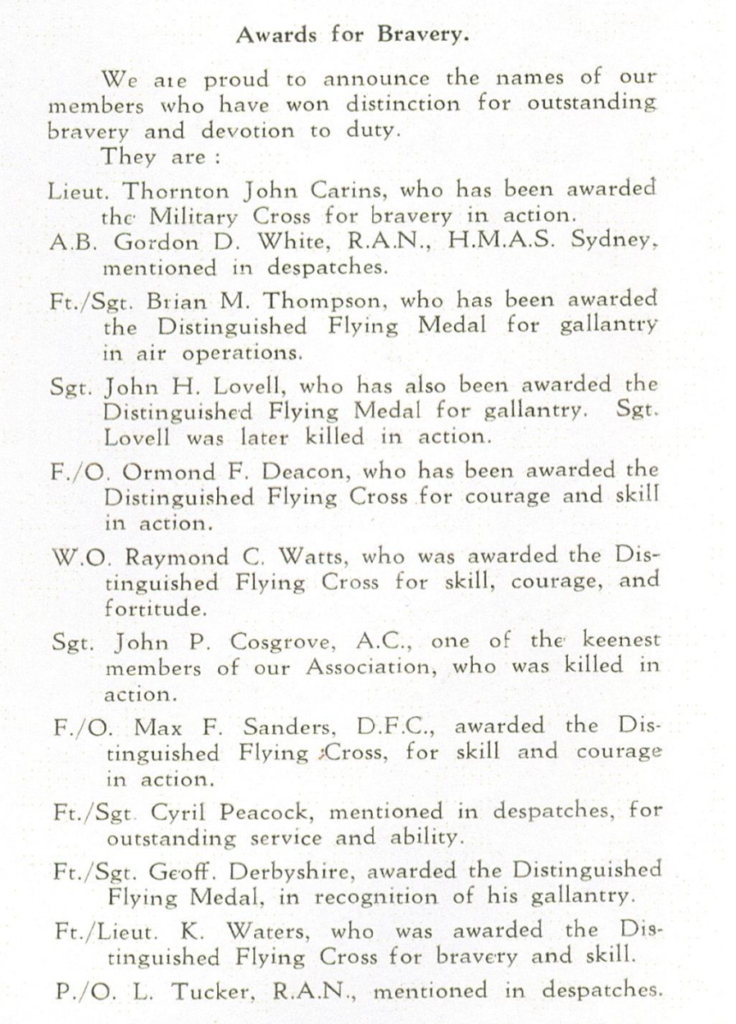
Tech – 1950s
Junior Tech in its last decade to 1959 had five Headmasters-
- 1942-1951 Lewis Edney Amos
- 1952-1956 Elliott Wilfred Woolley
- 1956-1956 (Mar to Dec) James Woodruff
- 1957-1958 Philip John Clifford
- 1959-1960 Francis Hilary Arthur O’Shannessey
Two features of the school in the 1950s was the growth in student numbers and secondly the development and start-up of the new school at Queechy.
Students at the school in 1950 were 383, but numbers rapidly increased (1953-440), (1955-580), (1956-620), and by 1959 reached 900.
The desire for a new school had been the topic of conversation from the 1920s, but with depression and war challenges, the building of a new school continued to be delayed. A strenuous effort was got underway by Mr Woolley, he being the main driver of the project. A number of possible sites came to attention, Mowbray, Riverside and Queechy, with Mr Woolley preferring the Queechy site.
The area consisted of 25 acres of relatively flat land, providing room for multiple school buildings and sporting areas. The property was purchased in August 1954 and was scheduled to begin in mid-year 1955. The first intake of 220 students, all boys, took place in 1958, but the next year would be transferred to the Wellington Square campus, then moving back to Queechy in 1960.
Death of Mr Woolley
A notable but sad event was the death of Mr Elliott Woolley, who had held the position of Headmaster at the school for four years. He was aged 57 years. In the 1956 Technicalities magazine, the following Tribute was recorded.
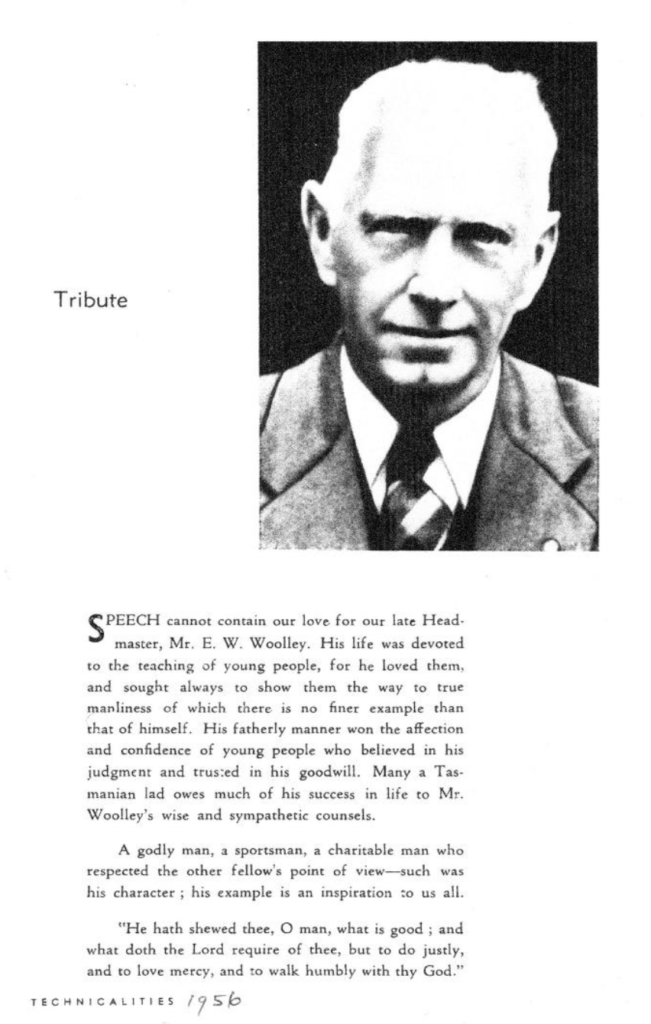
Queechy School Plan
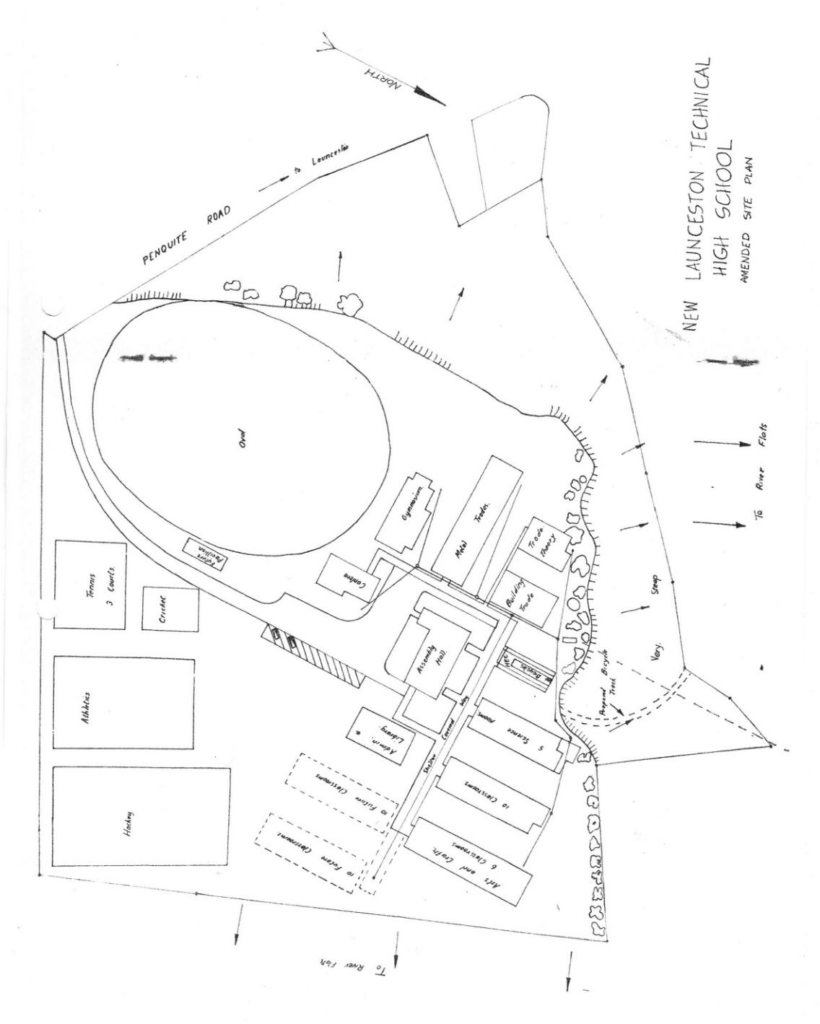
For several years the two schools worked together with some classes being held in each centre, e.g. my A Class practical chemistry class being held at Queechy on half a day each week.
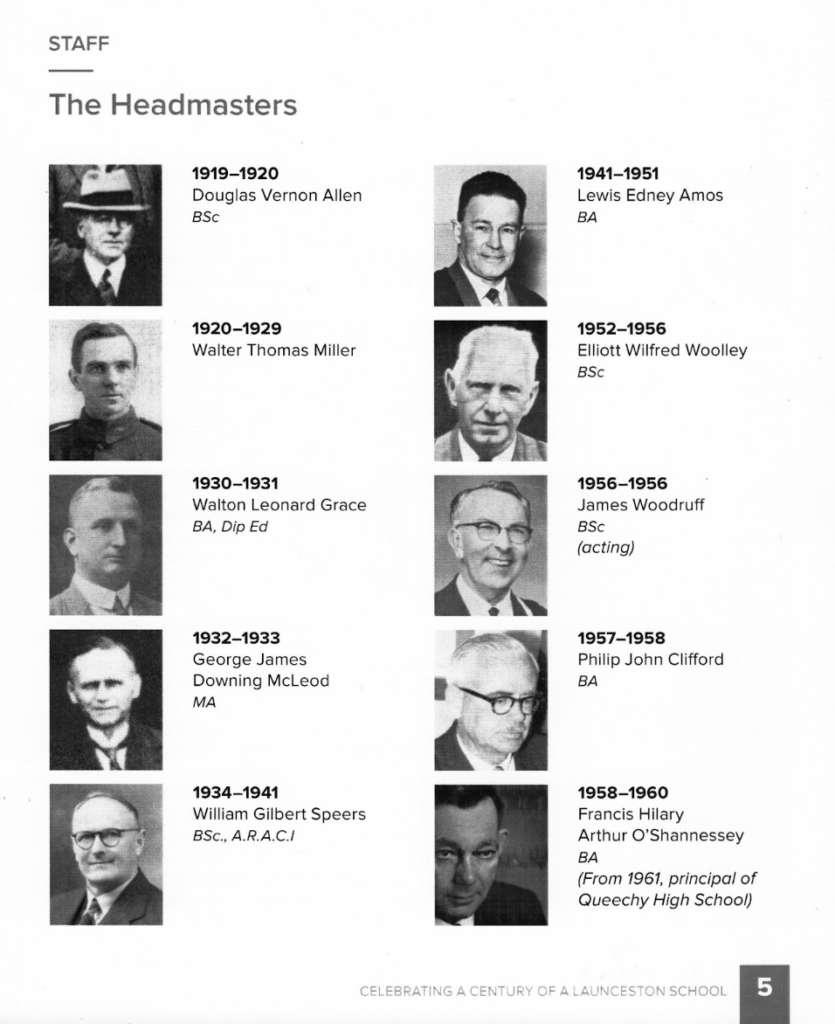
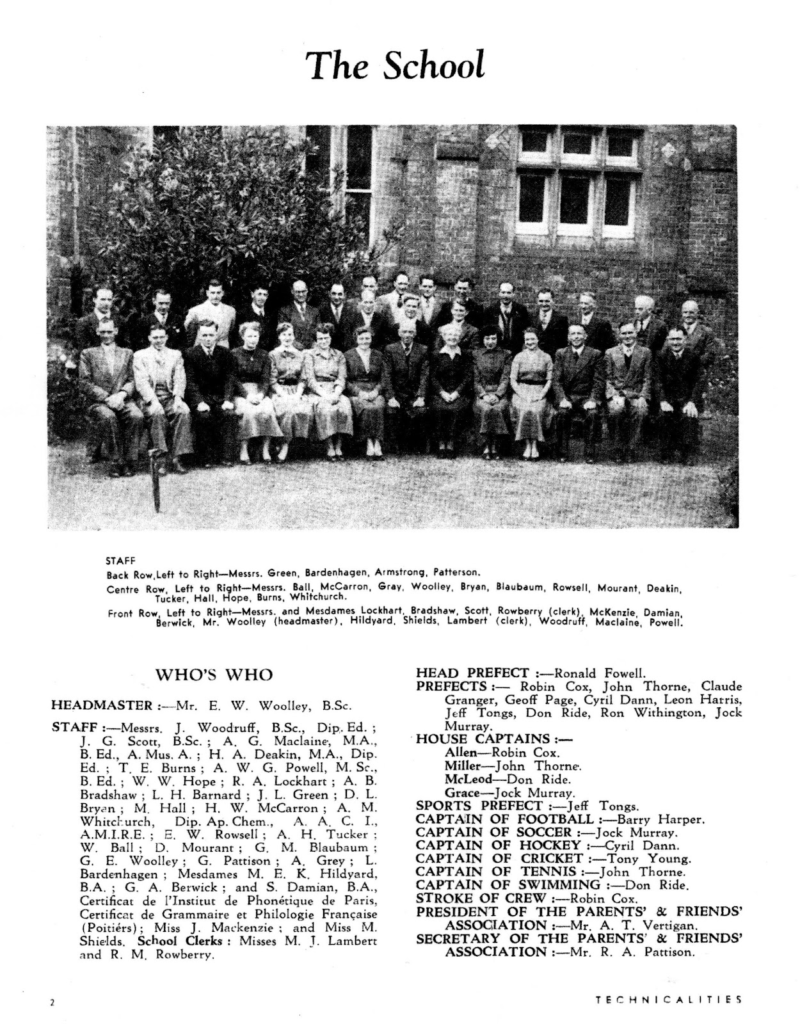
Fullbright Teacher Exchange
An event that caused much interest was the arrival of Miss Edna Hartness from America in August 1958. She came under the Fullbright Scheme, exchanging with Mr Jack Curtis, a Tech school English teacher. She was a teacher of English at the Harry P. Harding High School at Charlotte, North Carolina, and while here, taught English, all-be-it with a Southern American accent. She was a very pleasant teacher and much loved.
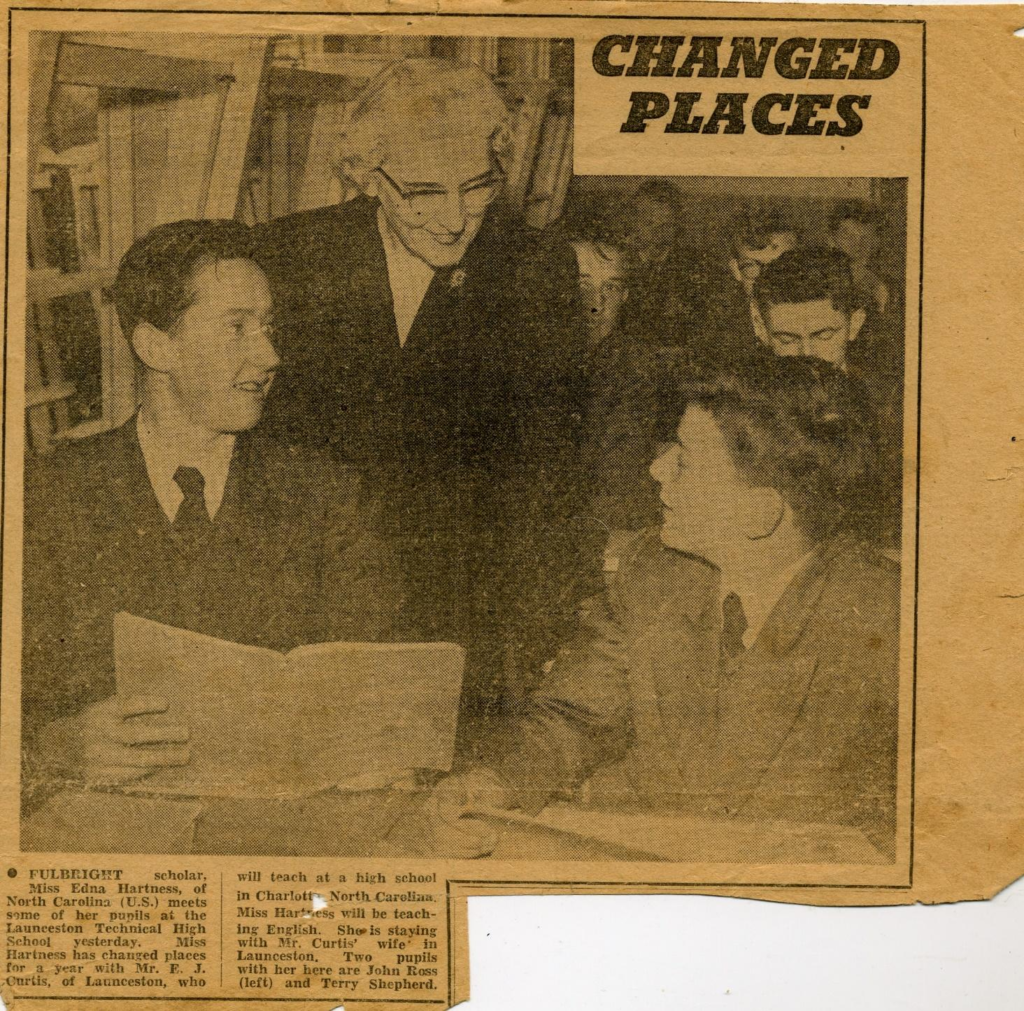
Hobby Hour –
Hobby Hour was held on Thursday afternoons with students being able to follow pursuits of their interest with the exception that non-swimmers were sent to the “Learn to Swim” group who met at the very chilly Tech College swimming pool next door. Those learning to swim were then allowed to join a hobby group of their choice.
Groups included Cadets (Army and Airforce), Science Club, Discussion/Debating, Dramatic Club, School Orchestra, Choir, Mouth Organ groups, Leathercraft, Chess Club, Mapping, Electrical, Library Assistance, Repair Club, Aeromodelling Club and others.

The Science Club
In 1958 it had 32 members, and they were meeting at a time when there was much interest in rocketry and the launching of satellites. Jan Boersma was a leader in the Club and began to build small rockets and power them for launch. Originally, they were built out of cardboard, but later metallic piping and powered by zinc dust and sulphur. Early models blew up, but the problem was solved by adding baby powder to the mix to slow the burn.
The last launch went well, the rocket rising into the sky, turning and heading over the city. With alarm bells ringing, rocket launching was banned. Some years later, the remains were found atop of the Coles roof, a block away.
Jan and the group then turned their attention to electro-plating and astronomy. It included the building of a telescope.
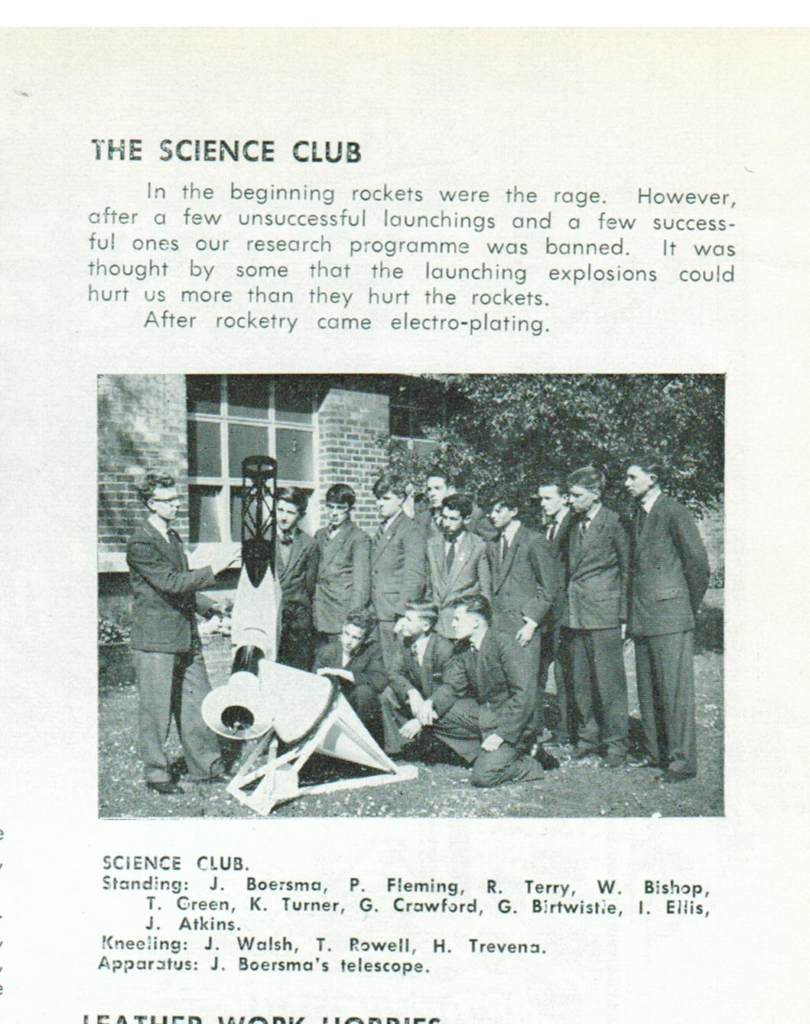
The telescope eventually found its way to the Inveresk Museum and placed on display.
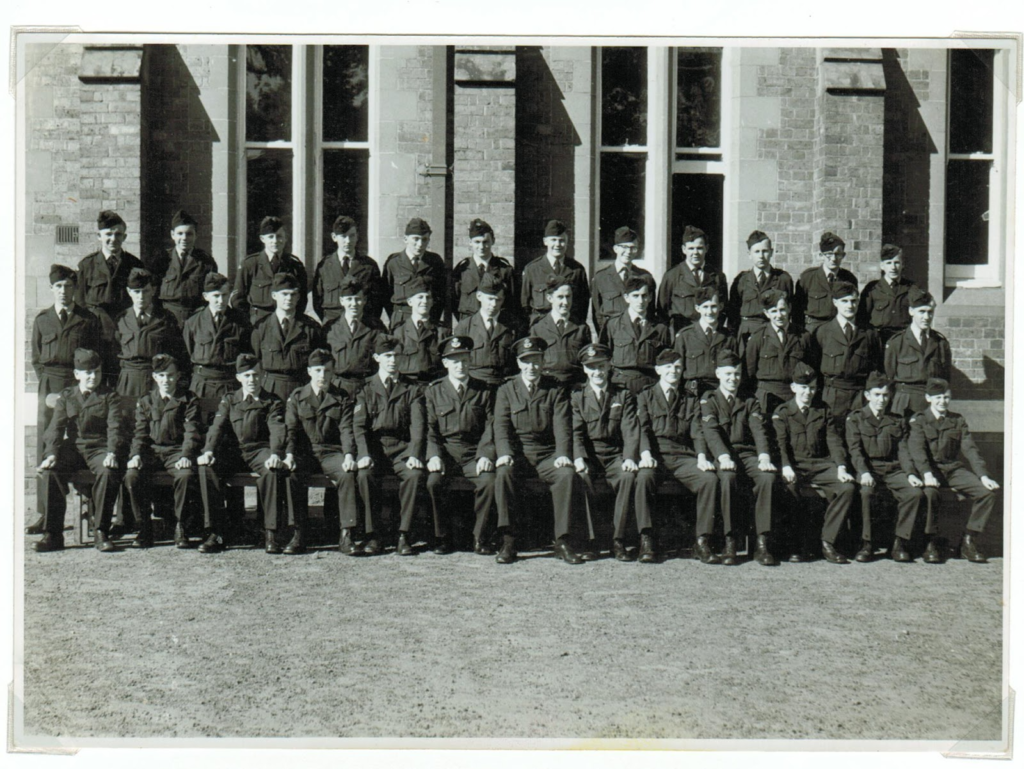
7 Flight – Launceston Technical High School – 1959
Wellington Square Campus
Front (L – R) – Robert Morrison, Terry Wilks, Brian Cole, Martin Crawford, Ivan Badcock,
P.O. Edwin Rowsell, F.Lt Alan Tucker, Mullock, Max Freeland, Barry Hill, name unknown, name unknown, name unknown, Barry Cottrell.
Middle (L-R) – Martin Stevenson, Ian Burns, David Baulch, Julian Wise, Brian Meehan, Kevin Lamb, Ian Nicholas, John Ross, John Woolnough, John Prewer, Tony Hart, Kevin Preece, Ian Conn.
Back (L-R) – Graeme Jones, David Scott, Alan Hardman, Don Marsden, name unknown, Ken Mallison, Bell, Neville Bean, Denis Atkins, Wayne Templar, John Morley and Richardson.
Tech – Prominent Old Boys
Even though the school only operated for 40 years and student numbers for some of those years were small, many became prominent in Tasmania and beyond. Some are listed-
- Eric Elliott Reece – Premier of Tasmania, 1958-1969 and 1972-1975
- Lance Herbert Barnard – Australian Deputy Prime Minister 1972-1974 and Diplomat at Norway, Finland and Sweden, also a Tech Teacher
- David Edward Llewellyn, AM – Deputy Premier of Tasmanian, 2002-2006
- Mac LeFevre – A member of the Tasmanian Parliament, 1958-1969, 1972-1976, 1978-1984
- Clarence (Clarry) Gandy Pryor MBE – Mayor of Launceston 1967-1968. As an architect, designed 20 churches
- Richard William Gandy – A Tasmanian Rhodes Scholar and Aeronautical Scientist
- William Leslie Bonney (Professor) – A Tasmanian Rhodes Scholar, teacher, and lecturer
- Geoffrey Sharman (Professor) – Expert in the biology of Marsupials
- Kenneth Gillespie (Sir) – a world renowned ballet dancer
- Peter William Crowcroft (Professor) – Researcher of animals, Manager and Director of zoos at Chicago (USA), Sydney Taronga Park, Toronto (Canada) – published 6 books and 53 papers
- Alan Thomas Gelston – Art teacher and sculptor, carved the Coat of Arms above the main entrance of the Tasmanian Parliament House
- Kenneth Richardson – A technician/advisor at senior levels of the PMG Department. Installed numerous automatic telephone exchanges in Tasmania, including Launceston
- Bruce Gowens – established the well-known Toyota Car dealership in Devonport
- David McQuestin – A prominent sports broadcaster, becoming Managing Director of ENT Enterprises from the 1980s to 1994.
- Fred Edwards OAM – He worked for St. Luke’s Medical Insurance Company for 47 years and developed it into a very successful business. He became its General Manager.
- Frank Cartledge – became a well-known and respected chemist at H. Eberhard and Company
- Arthur Lovell MBE – An aircraft pilot and captain and became the Chief Pilot for Ansett Airlines. In 1954 ferried Queen Elizabeth and Prince Phillip on their Australian tour.
- Malcolm Murray – the 12th. Earl of Dunmore took his seat in the House of Lords in 1988.
- Martin Stevenson – He was a prominent journalist with the Examiner Newspaper for many years, a second-hand book retailer, and more recently writing for the Longford Country Courier. Wrote numerous items on Tech and teachers.
- John Thorne (Dr) – A teacher and Principal, Tasmanian School for the Hearing Impaired.
- Mark (M.T.C.) Jessup – A radio engineer and electrical goods retailer at Charles St., Launceston.
- Percy Larissey – Garage and Transport proprietor, Cressy. The business developed into the State-wide Red Line Coach Service.
- Kenneth Charles Turner – A champion badminton player and described as one of the greatest sportsmen produced by Tasmania. Represented Tasmania on 10 occasions and competed/captained at an international level.
- Kenneth William Turner – An engineer. In the UK, led a team installing computerized traffic lights.
- Jaan Boersma – a lecturer at TAFE Hobart and Launceston and the University of NSW (UNSW), teaching physics and philosophy in religion.
- Neil Kerrison – Banker, TAFE educator in finance and Human Resources Manager at Tas Alkaloids.
- Bevis Howard – Banker and farmer and a manufacturer of cheese, sold throughout Tasmania
- William “John” Phelps (Dr) – School principal and an education consultant in London and the South Pacific, Tonga.
- Lloyd Whish-Wilson – A journalist at the Examiner at Launceston, progressing to senior management with Fairfax Media. Inducted into the Launceston Chamber of Commerce’s Hall of Fame.
- Graeme Merrington (Dr) BSc, BE(hons) Phd. – Head of Gas Turbine Engine Performance Research, Defence Science and Technology Organisation. Provided scientific support for RAAF aircraft including F111, F/A-18, Mirage and Nomad. Published many papers
- John Graham Hawkins (Dr) – A medical doctor and surgeon at Hobart and Alice Springs.
- Tony McCormack (Dr) (BSc, M Ed, Ph D) – Teacher of Mathematics and Physics + Education Consultant 1965 – 2012, Author of 3 Physics books (1970s); Author of 4 books on Farmers (2013-2019).
- Eric Padman – Became prominent as a Launceston optometrist and businessman.
- Ian Conn – A driving force of Walkabout 30 (1967), Australia’s first fundraising walkathon. Also operated a well-known/high-quality gift shop in Launceston.
Church Ministers (there may be others not identified)
- (Baptist) – (Reverends) Peter Mathewson and Ralph Terry
- (Methodist/Uniting) – (Reverends) Norman Pask, Gilbert Moore, Bruce Prewer, John Pettman and Dennis Hawkey.
Rotary District Governors
- Barry Dadson, Fred Edwards, John Thorne, Brian Beardwood, Richard Chugg and Lou Johnson.
Tech Boys who returned as Teachers – Alfred Bradshaw, James (Jim) Green, Allan Tucker, Geoff Pattison, Edwin (Ted) Rowsell, James (Jim) Arnot, Keith Fielding, Lance Barnard, Claude Fowler, James (Jim) Medwin, Max Hall, Jack Begent, Mac LeFevre.
Tech Boys who became School Headmasters – Jack Begent, John Thorne, Ken Neville, Peter Mathewson, Keven Bradley, Brian Butler, Bill Edmunds, John Phelps, Bevis Ross, Michael Sheehan, William Turner, Roger Edmunds.
Tech Boys who joined Banks – It is known that many were employed in banking but not all are identified. Joining the E.S.&A. Bank, 18 are recorded, with eight reaching management level –
- Lyle Cook
- Trevor Bomford
- Trevor McIntyre
- Alan Beardwood
- Ivan Badcock,
- John Baker; and
- John Sice.
At ANZ, seven have been identified as being employed with three becoming managers,
- John Guy,
- Michael Doyle; and
- Geoff Morice.
Sport
Sport played a major part in the life of the school. The usual sports played were football, cricket, hockey, tennis, soccer, athletics, swimming, rowing, sailing and badminton. With no grounds or facilities at the school, grounds and venues were used and travelled to throughout Launceston.
Each year a School Carnival was held, with the Houses competing against each other. Individuals and teams took part in other combined Launceston Schools events, including the Anzac sports. Games were regularly played between the Hobart and Launceston Tech schools. These events were mostly cricket or football.
A number of students became top-class athletes.
- Geoff Long, a first-class footballer, gained an Australian Blazer, National Carnival
- Noel Clarke, best full forward at the National Football Carnival
- T. Cowley, an “A” Grade Footballer and Cricketer
- B Hird, an “A” Grade Footballer and Cricketer
- T. Cowley, an “A” Grade Footballer and Cricketer
- D. Crosswell, a Tas Football League Carnival Player
- A. Wilson, Interstate oarsman, North Esk Rowing Club
- Mike Delanty, a first-class Footballer, recruited by Collingwood in 1957
- David Claxton, a Basketballer and Coach at State level in Queensland
- Glen Ion, Cyclist at the International level and holds numerous titles.
Remembrance
With the centenary of the school’s founding in 1919 approaching, a group of former students came together and conceived the idea of having a reunion to celebrate the occasion.
A sit-down lunch was decided with a display of memorabilia and with a small history booklet provided. A mid-day lunch was held at the Riverside Tail Race Centre on Friday, 8 March 2019. Attending were 250 “Old Boys” and four former teachers. The youngest Old Boy was just over 74 years of age, and the oldest 92 years. Most coming lived in Tasmania. A good time was had, and much reminiscing between boys that had not been in contact for decades. So pleased with the occasion that a number left expressing the wish for another reunion in the future.
A few got together next day (Saturday) and visited the former Wellington Square site, later going onto the Queechy school where we were given a guided tour of the school by the headmaster. He was the son of a former Tech student.

Memorabilia
At the Reunion, a large amount of Tech history was gathered, raising the question of storage and presentation. The matter was discussed with Queechy authorities, who were agreeable to providing space in the school library. Honour Boards were placed along a wall of the library, and two glass cases were purchased and filled with memorabilia, suitably labelled.
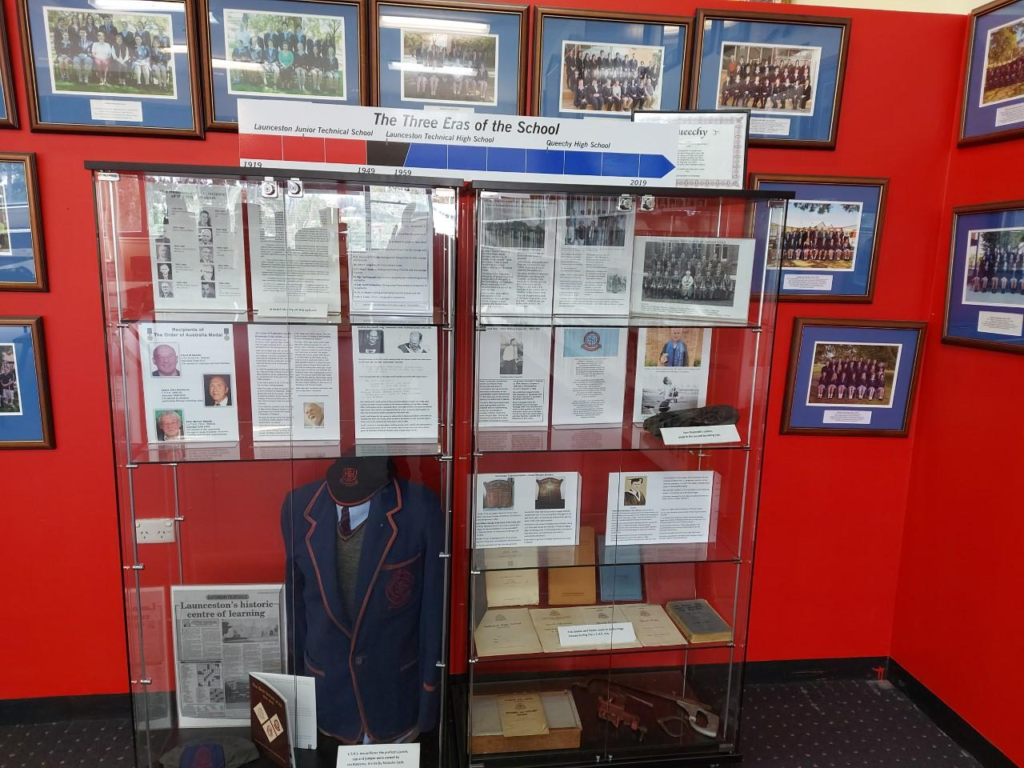

By Ivan Badcock – 9 September 2022 (A work in progress)

Did any Wynne-Allen family members attend this school?
Dear Mr Badcock
I’m so pleased I discovered this page.
The picture of the school cadets was a most pleasing discovery. Leonard Hill is my great uncle on my fathers side. Over the years I have been painstakingly removing old recipes stuck inside his grade 4 school work book to reveal his lessons and writings. It has been an entertaining and educational read of a young boy. From a Circus visit to hunting rabbits, and a plane flying over him. Which I guess would have been quite novel to him at the time. And letters to his sister and family. He went on to join the merchant Navy, his father retiring from the Navy whilst he was still a boy.
I am also a descendent of John Alexander Herbert. (Herbert, Chapman, Goodyear, Hill, Browne.)
Thank you for your contribution
Sincerely Yours
Megan Marie Browne
Dear Mr. Badcock,
I have just looked up your article on the history of LTHS to find out who were the headmasters of the school from 1950 to 1959 to settle a debate i have had with a former student.
What an amazing publication you and your colleagues have produced.
Just recently I have met with my class teacher of 1956 D7 Mr. Edwin (Ted) Rowsell who I last encountered at the 2019 luncheon. and we had a wonderful chat, what an incredible man he is turning 97 years old in June.
Fondest regards
Keith Dixon Student from 1955 to 1958